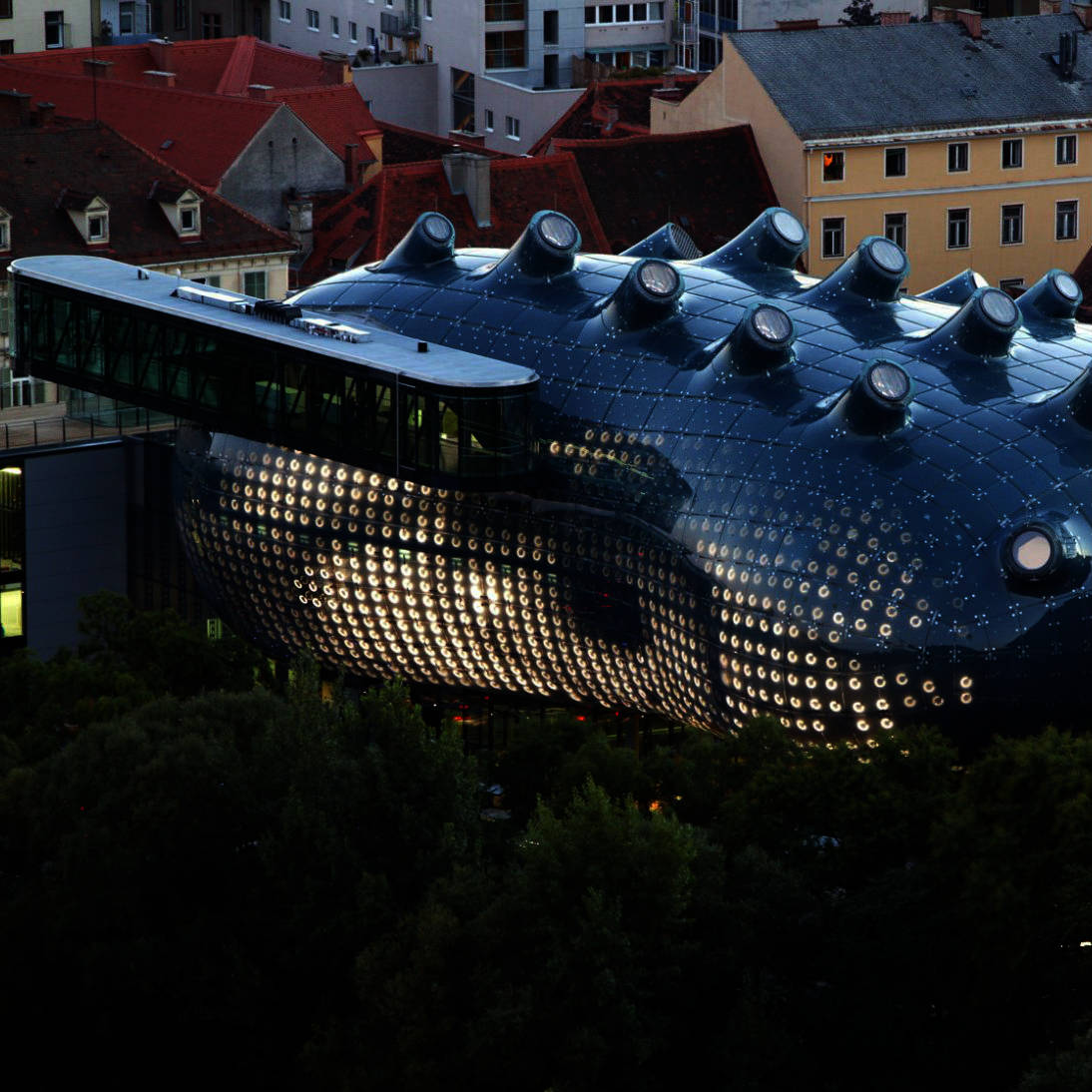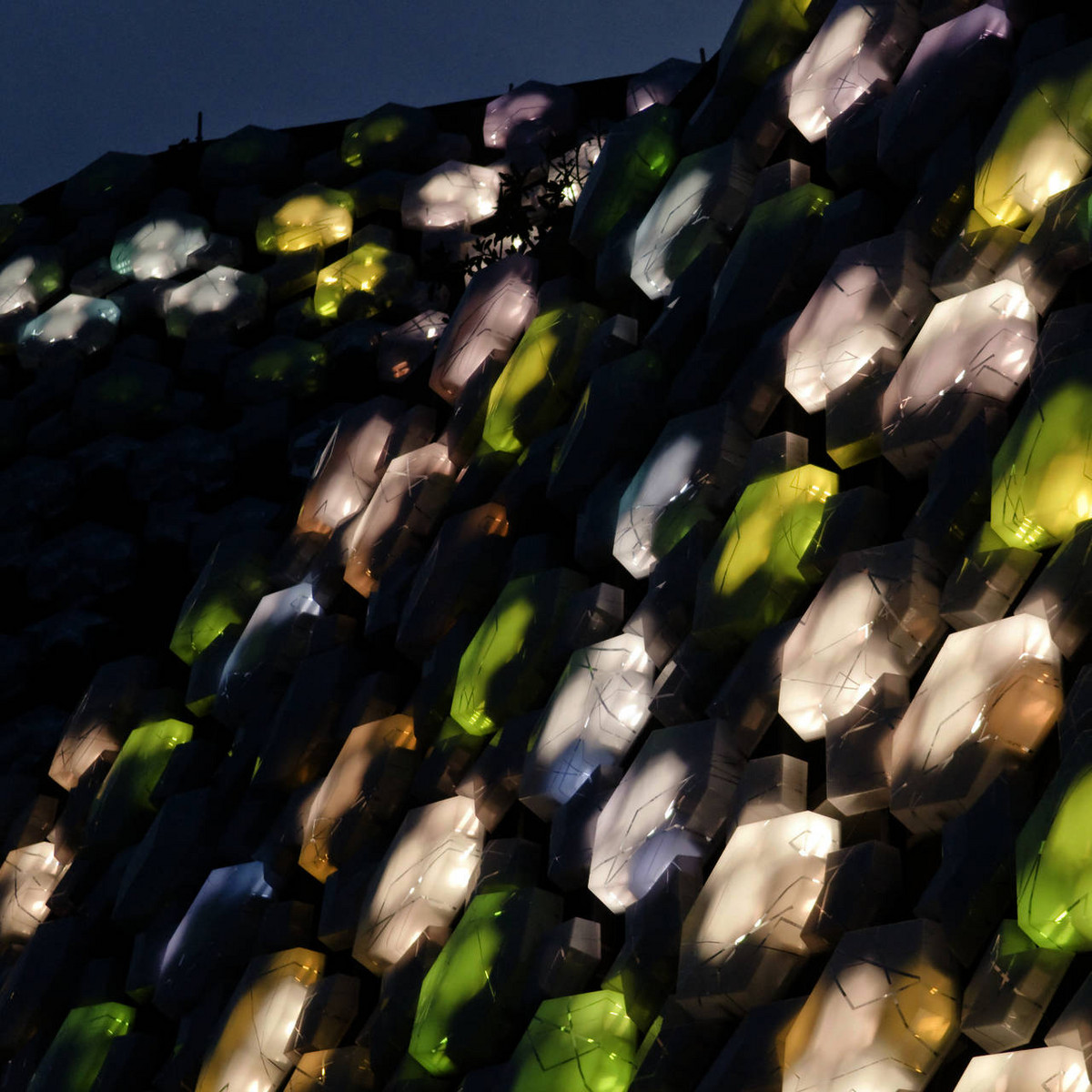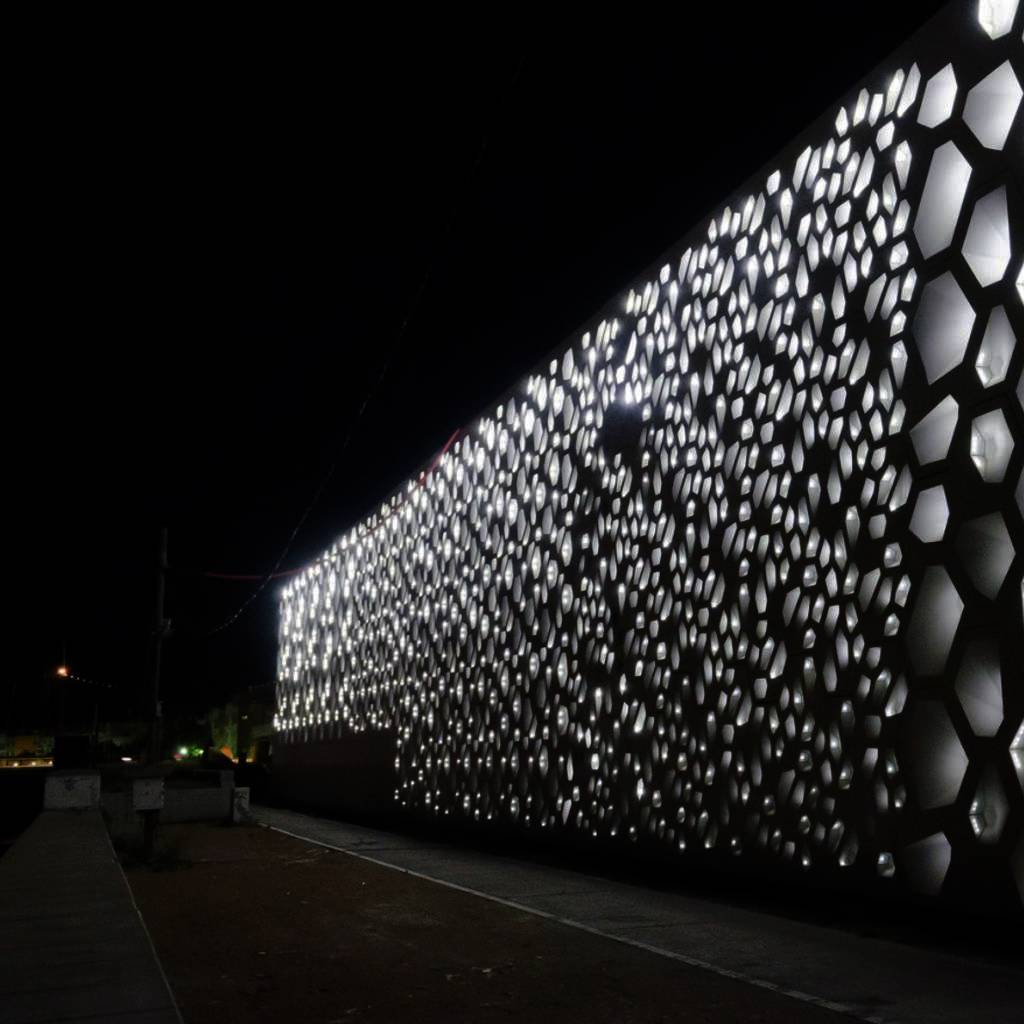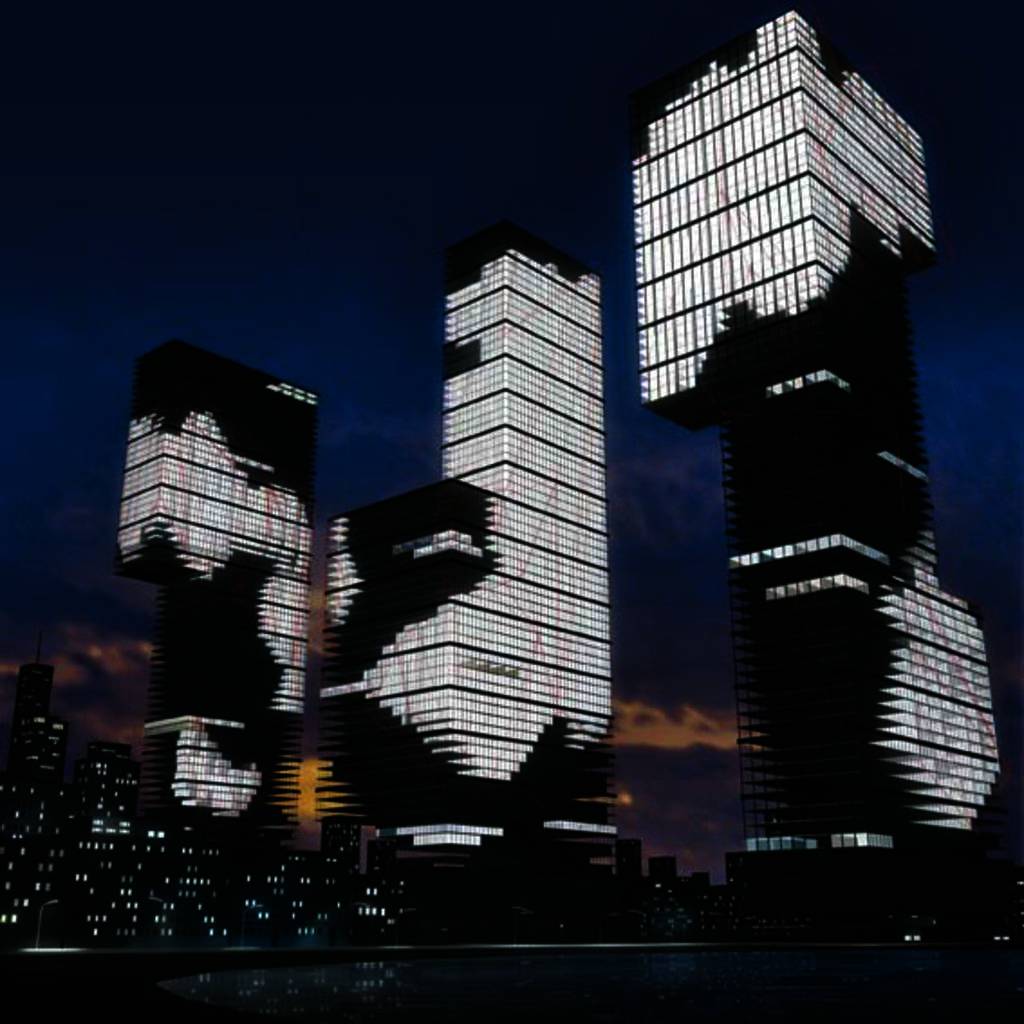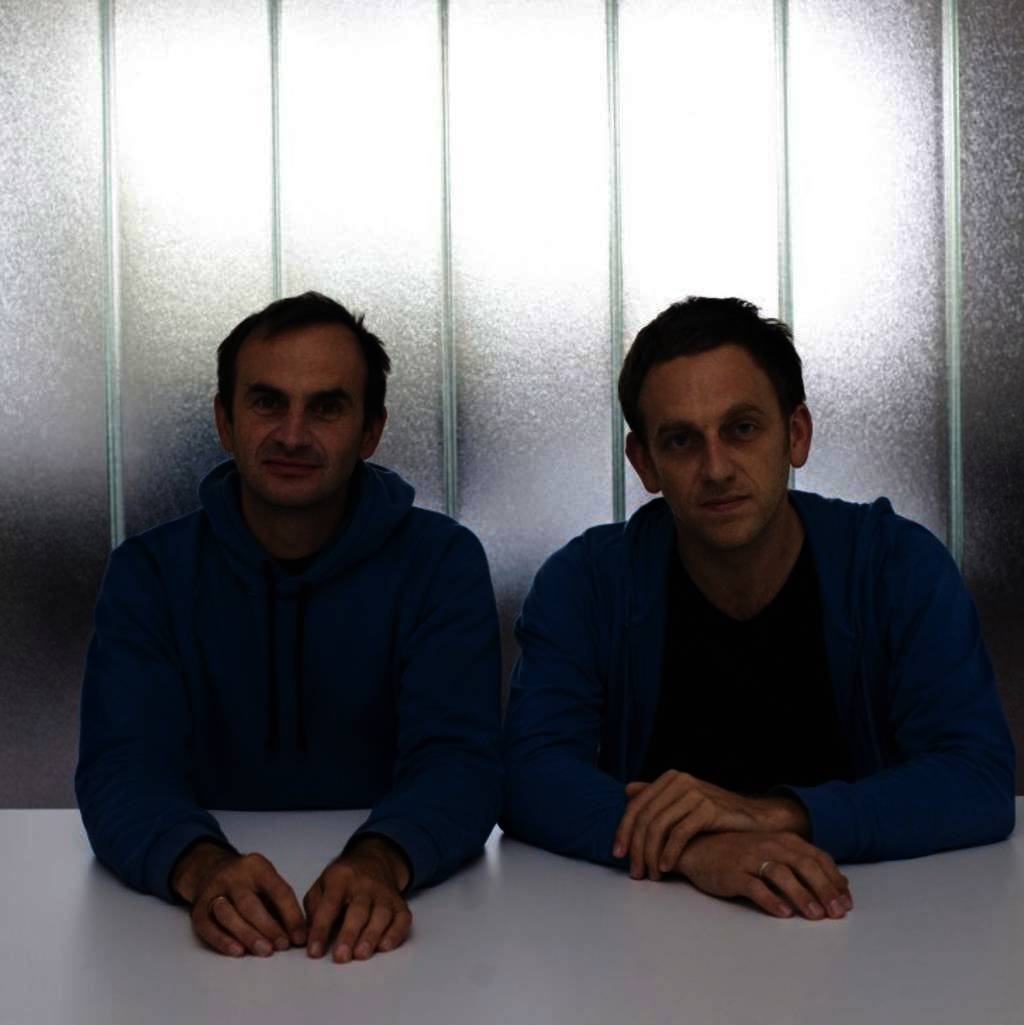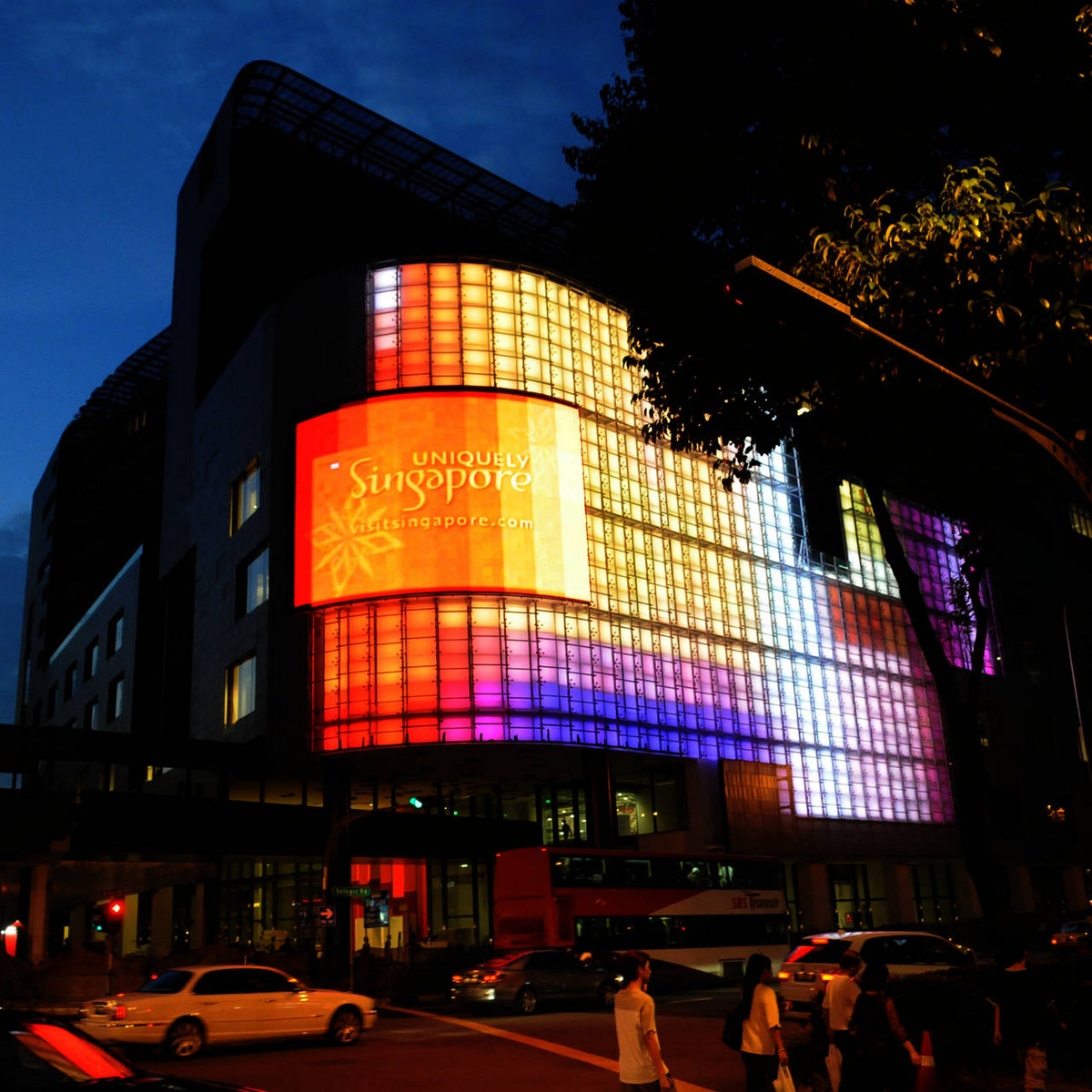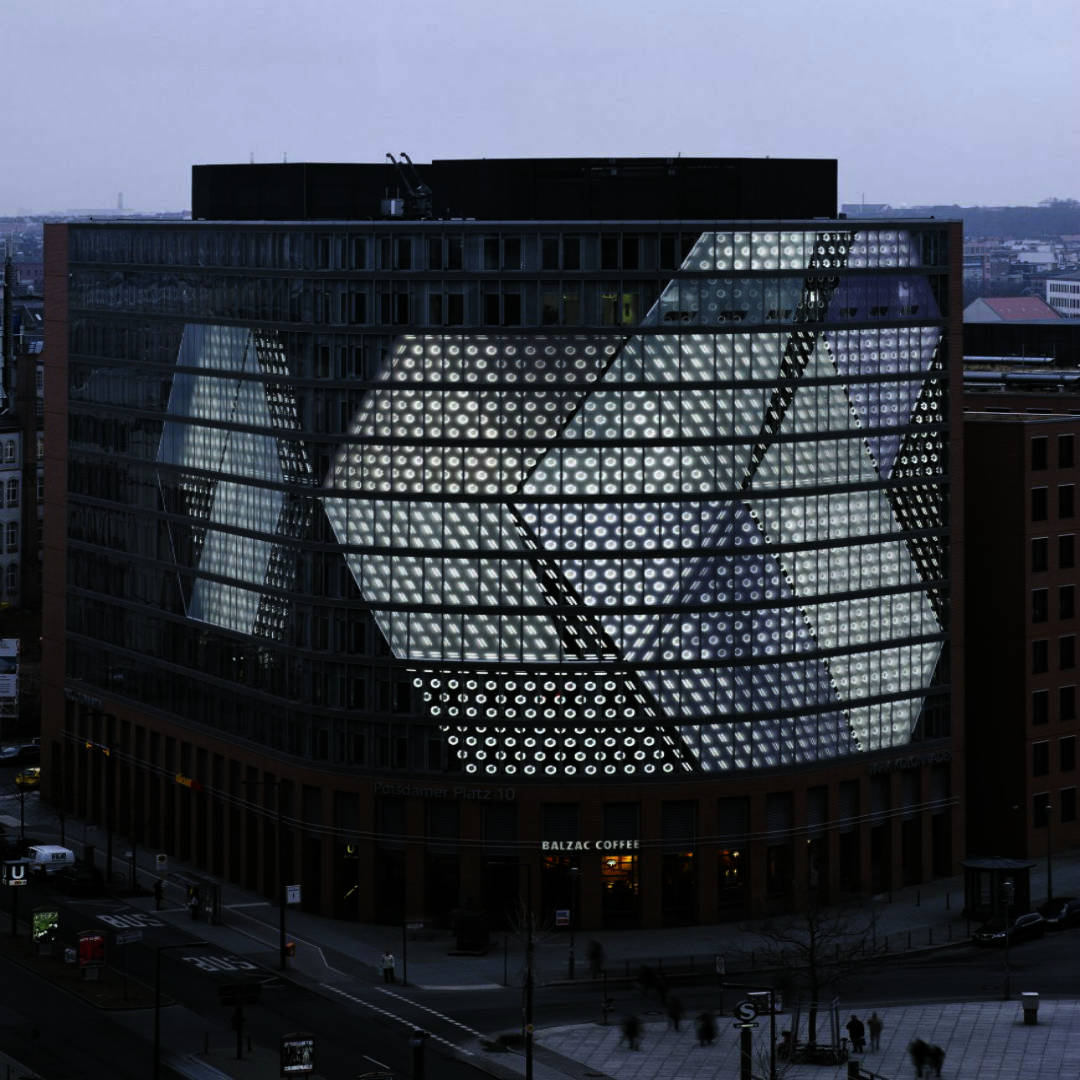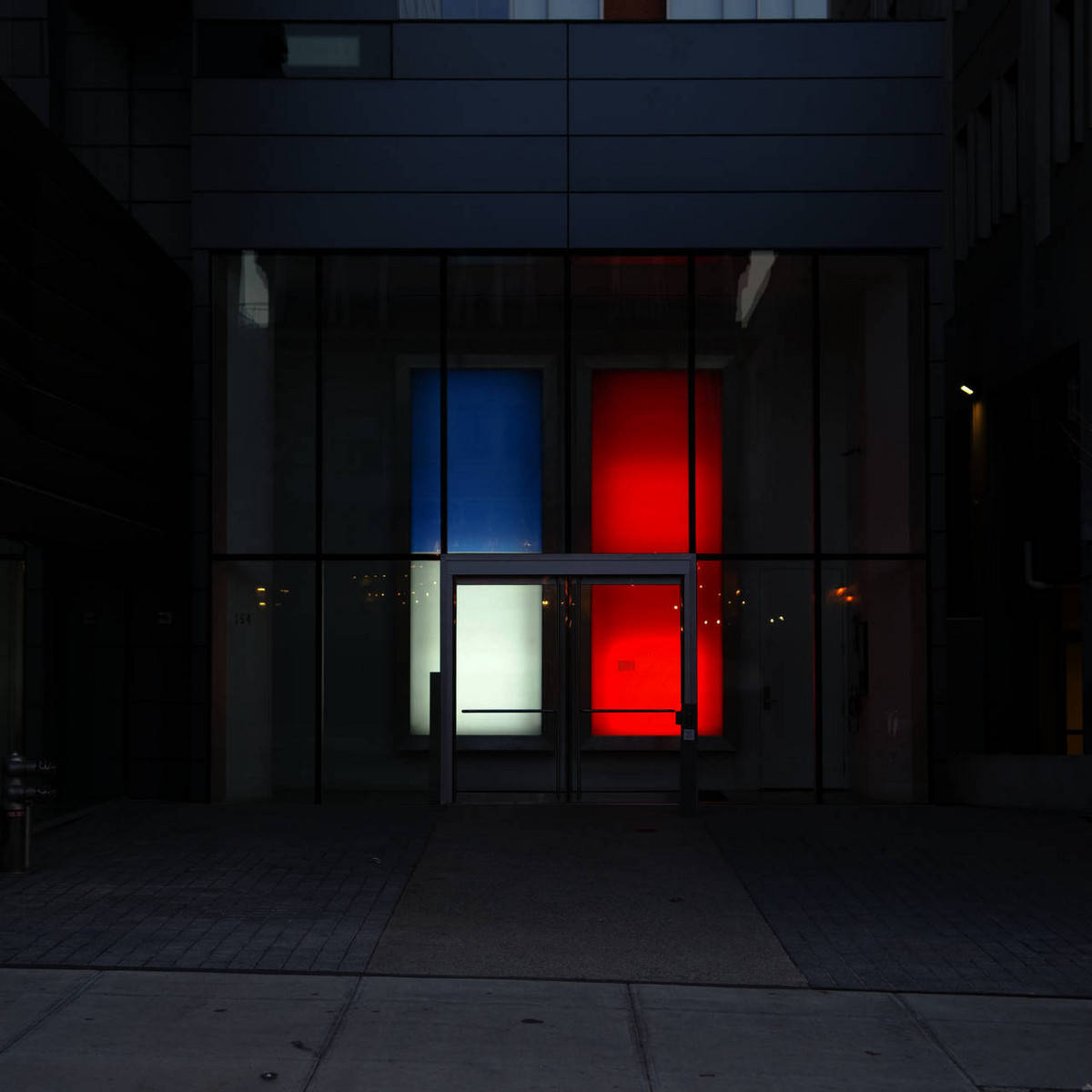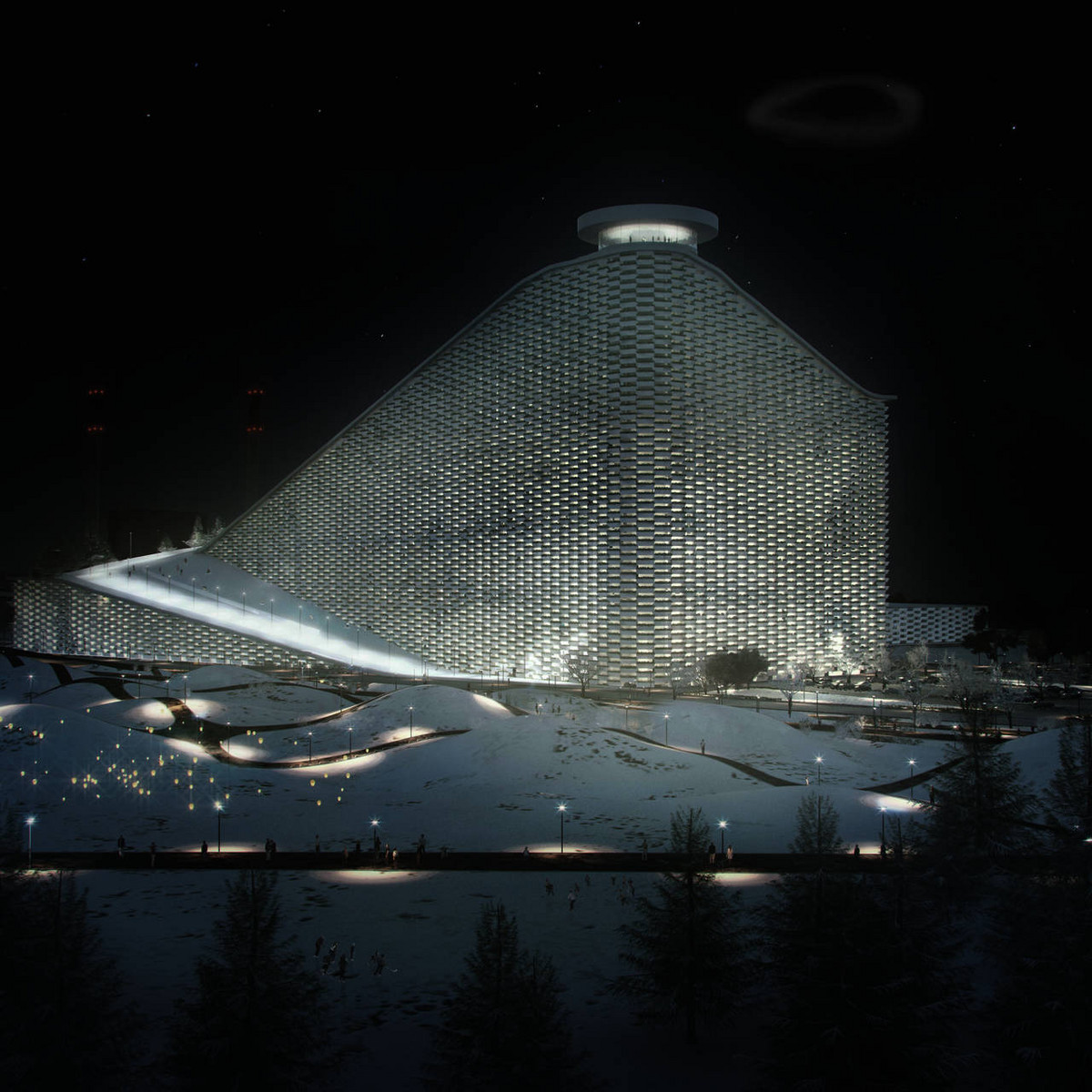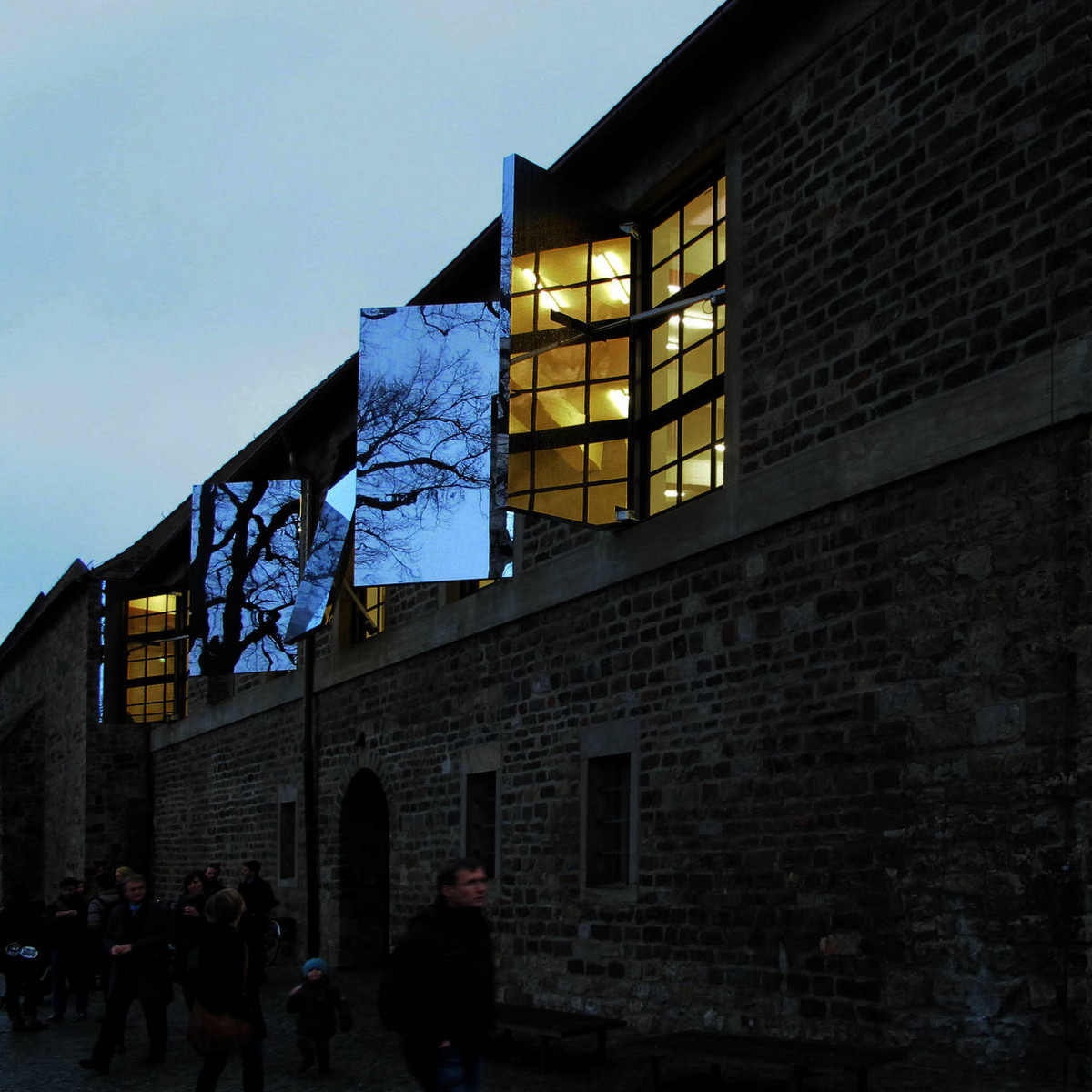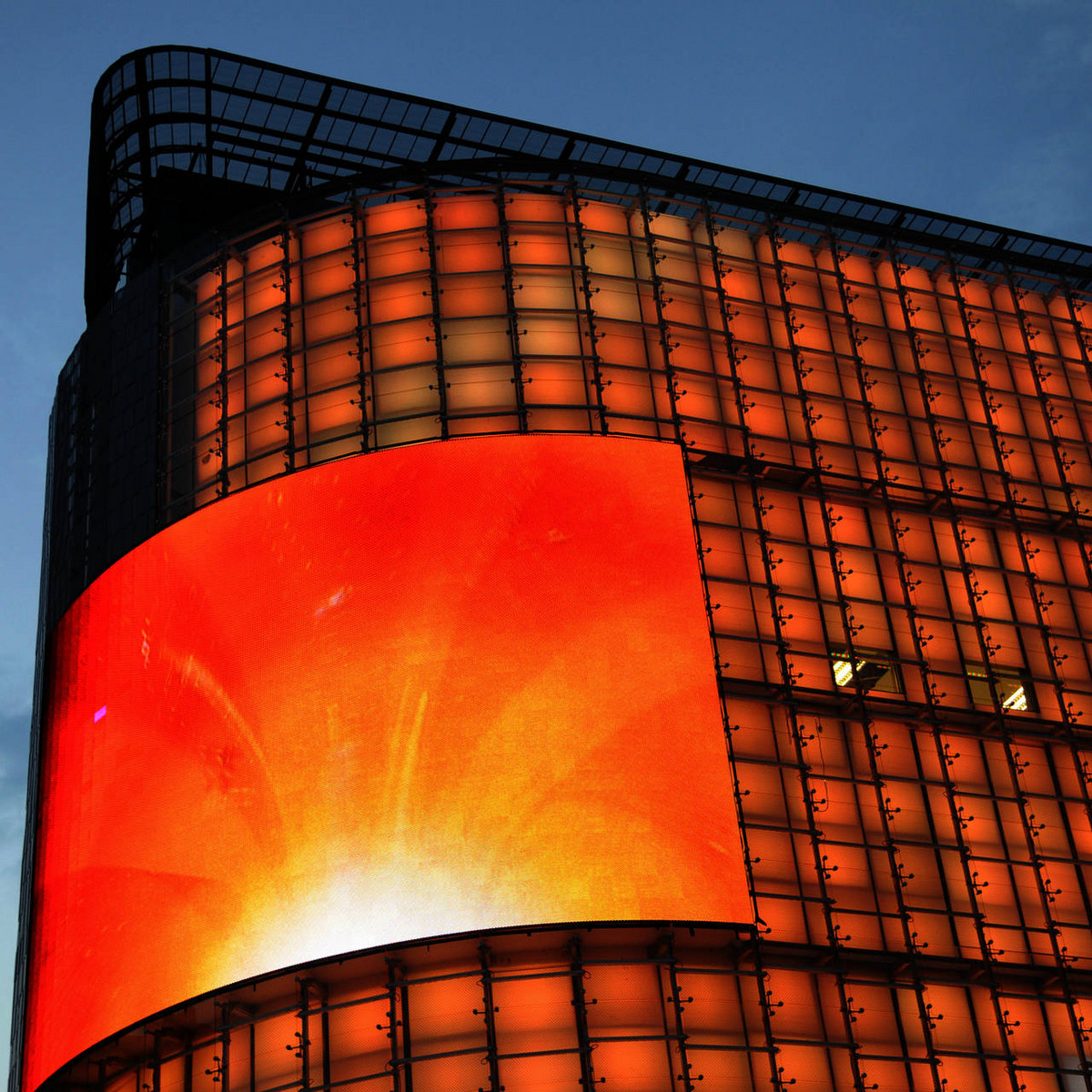»Wasn’t there something else yesterday?«
In 2000, the brothers Tim Edler and Jan Edler founded realities:united, a studio for art, architecture and technology. The »masters of light« are renowned as experts for media facades, digital surfaces, lightning design in architecture. Exhibition curator Jolanthe Kugler spoke with Jan Edler about his work and his engagement with light.
You work internationally and are generally commissioned by architects to design a media facade in collaboration with them. You trained as architects. How and when did you come to work with light?
We are trained architects and have always worked in that overlap between art and architecture. Currently one of our main areas of work is art in public spaces, but we came to the subject of light and media facades rather by chance, prompted by the BIX project (2003) with Peter Cook for the Kunsthaus in Graz. When working with him we asked ourselves how we could maintain the communicative power of the architecture – after all, this was a design which had actually been planned as a transparent building, but was no longer transparent in its final shape. We tried to restore the building’s communicative abilities as associated with transparent architecture, and to do this we went down the media route. Our aim here was not really to become specialists in media facades, but rather we were simply thinking, »How can this architecture communicate?« The many facades that followed are also, in this sense, part of a research process: you can clearly see how the process has developed. A possible guiding question for us could be: what is the pixel of the architecture? It doesn’t have to consist of light, but can be something entirely different. At the end of the day, it’s all about how the architecture behaves, or what happens to it, when it becomes dynamic. This is an ancient dream of architecture. Thus light and media technology are now suitable and available technologies for the realisation of the first beginnings of the cybernetic facades or robotic architecture that Peter Cook was dreaming about back in the sixties. Tomorrow it may be completely different technologies.
You realised your first light projects at the end of the 1990s. These included LiMo in the Monbijoupark in Berlin, where you fitted the old street lamps with new fluorescent tubes, mounted like halos around the lampposts. How did you get involved in this project?
At that time we had our first workshop. Together with some friends, we founded the »Kunst und Technik« art association, and we used the hut of the Charité hospital’s former animal testing unit in the Monbijoupark as a laboratory, exhibition space and club room. It was one of those typical unused spaces in what had been East Berlin which no one really knew what to do with. At the time even the Monbijoupark, although very central, was a no man’s land and was not even lit. The former eastern-style lamps in the park were »dead«, so we illuminated the park and disguised it as an art project. We hung the luminescent tubes on the dead street lamps like parasites and ensured the electricity for them was provided by sponsors so that the city didn’t have to spend any money. That’s how it all came about. LiMo – Light in the Monbijoupark (1997).
Was that the first time you worked with fluorescent rings?
Yes, and we learnt from our mistakes too. Because the pipes hung freely in the park, everybody said they would be vandalized immediately. Most of them, however, were broken not by vandals – the lights were obviously respected or well received – but because we had soldered the end pieces of the fluorescent rings to ensure they would be waterproof. They could not take the thermal stresses; it was simply a construction error.
Previously you mentioned the communication potential of architecture. Why should architecture communicate in the first place?
That’s something it should always do. And if the architecture itself doesn’t take that into consideration, then others will, predominantly with the application of new technologies that can be used meaningfully. Often advertising takes the lead here, attempting to make the architecture a tool. We believe, however, that this shouldn’t change the actual function of the facade as an interface between inside and outside.
What type of communication are you trying to achieve? You don’t actually make classic media facades as can so often be seen, where a screen is hung on the front of an existing building; you go much further. Indeed, your work gives the buildings a new depth; they react differently to day and night, and often also get a graphic component during the day which emerges from the patterns of the light sources on the facade. How important are the day and night views of a building for you and what is their relationship to one another?
As far as our concepts are concerned, it would be wrong to think that we simply put screens onto buildings and thus transpose the television, film or computer screen format onto the building. Why would we do that? We are actually looking for other solutions; here it’s all about huge scales, about aspects of visibility by day and night. We experiment with creating graphic levels or three-dimensionality with lights, with which these installations give the building a face during the day too. A particular example is the project Crystal Mesh (2009) in Singapore, where the facades actually morph into what is essentially a three-dimensional skin wrapped around the building, giving the building as much in the day as it does at night. The same applies to the C4 facade for the Contemporary Art Centre by Nieto Sobejano in Córdoba (2012). That is precisely the pixel research I was talking about: we often work with rudimentary resolutions and do not therefore pander to people’s expectations about what a screen should be. It doesn’t always have to be HD and full-color; what’s much more important is that it is developed to be specific to the location. Many of the facades we have created are more like platforms for which artists are to produce changing content, as at the Kunsthaus in Graz. This works well with some projects, but fails completely with others. That’s why many projects now have specific artistic content clearly defined by us.
What role does the observer play in your facade concepts? What should he perceive? Is he or she crucial when it comes to determining what happens on the facade?
Of course! If, for example, an artist is producing a work for our facade on the Kunsthaus Graz or in Córdoba, then it can include interaction throughout, since the software we developed is open enough to permit this. On the other hand, we see interaction not merely as an end in itself, since we never want to give the impression that the designer simply wanted to offload responsibility onto somebody else at the end of the day. Many of the interaction projects we are familiar with nowadays from the art world provide only short-lived excitement, because you want to do something for a moment – but you can’t actually communicate anything, really. And lots of things are more reactive than interactive. You could of course say that a light switch is interactive, and you wouldn’t be wrong: I can turn the light on and off. But how can I produce real added value with it? Actually, in Toronto we are currently producing an interactive work for the first time – LightSpell (2010). The project is for the Steeles West underground station designed by Will Alsop, and aims to create a hybrid of pragmatic illumination systems and art on the building. From the ceiling hang sixteen segment displays, similar to the digital displays of a radio alarm clock, and people can write texts and figures on them using quite normal keyboards available in the station. Their text appears immediately and illuminates the station regardless of what was written, with equal light intensity, because the computer dims the lamps accordingly. We planned the project based on the explicit exclusion of censorship, since limits should not be placed on creativity which should instead be encouraged. The segment displays, which are normally always seen on a screen, hang freely in the space like a type of digital chandelier. The idea behind this is that we don’t add anything, but rather take the otherwise still pragmatically necessary technology – lighting – and use it in a different way. A similar thing happens with NIX, a concept for lighting orchestration in high-rise buildings (2005), which we developed through to the marketing-ready stage as part of a commission for the development of the night-time appearance of the new ECB building by Coop Himmelb(l)au in Frankfurt am Main. A modern office building is full to the brim with automated features, light and sun protection systems, which are all centrally controlled and are considered only from the pragmatic user side and not, unfortunately, as a potential design element of the architecture. And that is precisely the aim of NIX – that pragmatic lighting is used as a communication tool, it penetrates the architecture; we use only what is intelligent, what is actually already there and what breathes new capacities into the architecture. Architecture critic Andreas Ruby once called it the »deep-tissue massage of architecture«. That is, I believe, a really nice image. Unfortunately it was not realised in Frankfurt.
If external walls no longer have to be made of stone, and the facade can be replaced by something quite different, what then becomes of architecture?
Yes, you could be horrified, since architecture has long tried to detach itself from ornamentation and from pictures – and now people are coming along with these stupid media and sticking the pictures back on. This shouldn’t be done without careful consideration, but rather it should develop from the architecture itself.
There is always a tension between your work and the building itself. Let’s take the example of the Crystal Mesh project in Singapore – that is a facade with extremely strong expression.
That’s right. In that project the architects – WOHA in Singapore – were familiar with our work and wanted to clothe the concrete facade of the building with a glass facade. The glass facade was actually only for the purpose of hanging our bulbs from Graz in the in-between space. We said to them we thought it was questionable to build a glass facade that the building didn’t need, and suggested that they re-assign the budget for the glass facade to us. We would develop a concept to give the building a certain depth and dynamic even during the day. The result was this »clothing« of deep-drawn polycarbonate bodies that have inner reflectors that glisten in the sunlight. Another current project that’s interesting from this point of view is a high-rise building in India, where we are involved in the conception phase of the entire facade development. The client came to us because they wanted to buy these elements of Crystal Mesh from Singapore for their facade. We told them we are not a lighting manufacturer. Instead, we proposed a facade that takes into account aspects of sun protection, but can also convey that it is a building for the Bollywood industry. In summary, then, you could say that we do not supply finished solutions, but rather concepts that are always adapted to the context.
What was the process behind your collaboration with Nieto Sobejano Arquitectos in Córdoba?
Nieto Sobejano had won the competition for the Contemporary Art Centre in Córdoba and, as part of their contribution, had proposed that the facade facing the Guadalquivir river be designed as a media facade with which artists could work and thus communicate with the surrounding area. Their proposal was to create this media facade in a perforated format as a concrete facade with round holes, behind which hang colorful luminescent tubes. When we were consulted, we realised that the idea of the light behind the facade wouldn’t really work, because it would create a type of shadow mask. For this reason we brought the light forward to the front of the facade, where it could shine and depict the inner structure of the building typographically in pixels. The form of these hexagonal structures is based on the ground plan of the building, which the architects developed from their enthusiasm for tessellation patterns. Since there wasn’t a lot of money available, we had to make large pixels. However, since the building is 110 meters long and only eleven meters high, we were able to insert a lot of information lengthways but not much upwards – this meant very little could be presented. That’s why we opted for areas with varying pixel sizes and densities. The underlying idea was to create a facade which functions similarly to the human eye. It is constructed so that the center of the »eye« has a relatively large number of receptors that supply information, while the outer sections have relatively few. It therefore not only reflects our eyes, but also the far end of our brains. A person thinks he or she sees a sharp image, but that’s actually not the case; the head leads us to believe that, because it knows that it must be the case. And that’s the way this facade works too – if you take in the various areas with their different resolutions, the eye pulls the information together and recognizes what’s happening on the facade.
In classic architecture the passer-by himself decides whether he wishes to pause and look at a building or not. Media facades do not offer any choice in this regard: they are there, demanding attention with flickering images and changing light. How do you deal with this controversy? Does the building ever go to sleep?
The type of installations that we have so far realised and devised do not allow us to show any number of videos on them. The resolution is too rough for this; they are too limited, too basic. Here it is necessary to develop tailor-made, very minimal, content that fits with the specific location and the particular prerequisites of the installation. One project that was particularly interesting in this regard was Spots (2005) at the Potsdamer Platz. There we created a temporary installation which actually served to market the property. We then convinced the client to realise a purely artistic programme: as part of the curated »exhibitions«, works by Carsten Nicolai, Jonathan Monk and Terry Gilliam were developed for the facade, which were each displayed exclusively for four to six weeks. We also suggested leaving the facade blank on a Monday, since museums shut on a Monday. In addition, there was a type of sleep mode for late at night, like the sleep lights on a computer. Incidentally our newer works are essentially becoming slower and slower . . .
How do you develop the projections and images that appear on the facade?
Here we often base our work on the proportions or the pixels of the facade, or perhaps on potential sources of inspiration in the vicinity. With the installation AAMP in Singapore (2008), for example, we took an advertising screen as a basis, which was a fixed component of the building, and developed intelligent software that transformed these advertising images and used this information to play on our very rough-resolution facade installation. And during the times when this urban screen normally fills the unsold slots – ad breaks in the truest sense of the word, with so-called pretty pictures that are generally images from National Geographic, weather reports or short news bulletins – the low-resolution installation even takes over the control of the advertising screen in the form of feedback, generating something new from the advert material. It takes the advertisement as a kind of trove of raw materials for art videos generated in real time. In a wonderful way this creates a place reference, because people have perhaps already seen the same color or format when passing by. We thus give the architecture an ability to jog the memory. Our software analyses the available images in real time in the background – for example, for cutting speed, color distribution or even for recognizable motifs. A series of algorithms is then used to convert this information into an abstract color creation which always has something to do with the original motif, and recognizably so. At the same time, though, there is a strong connection with the architecture, since our installation takes on a type of interface role with the advertising screen, which can be seen as somewhat anti-architecture, trying to steal the show from the building. The installation doesn’t negate this, but always blankets just the facade sections which hide office spaces that are not being used at that point in time. We use sun-protection blinds as projection surfaces, which are controlled by motion sensors so that when it is dark and there is nobody in the relevant room they are automatically pulled down. On the other hand, the occupied office units create »holes« in the facade surface, as here the »window-blind pixel« cannot be used – a permanent transformation stemming from interactions between users and the computer-generated light signals.
Both in BIX and at the Potsdamer Platz you have made the light sources visible. They become almost like graphic signs and have a strong 2D component. Even the images – if they can be called such – that flicker over the facades, are strongly abstracted as shadow figures or, in the case of Córdoba, speckles of light and shadow, which flit over the facade. Do you start with the image or with the light source?
Our approach is always a very pragmatic one. We actually only chose fluorescent lamps because they were cheap. We also thought it was interesting to take a robust technology that is well established, including in the minds of onlookers. We didn’t want to get caught up in this technology one-upmanship: am I new? am I sufficiently cutting-edge? That might be the way display technology works nowadays, but architecture – provided it functions well – doesn’t age as quickly. We want our technologies to survive and to be able to age with the building. On the other hand, neither are we fixated on analogue technologies – for the facade C4 in Córdoba, for example, we switched to LEDs at some point during the planning phase because they had become cheaper and it simply made more sense.
Would you find yourselves in difficulty now if you had to create a facade using OLEDs? They are completely shapeless, intangible; they don’t create any kind of impression – no form, no expression . . .
First, I believe that this technology is still a long way from being used on facades, not least because of the cost, UV resistance and so on. If it does become usable, though, there would be possibilities here to work differently on the graphic level. It is possible to »chop and change« technologies, as we did with the Kunsthaus in Graz. There, we naively thought at the beginning that it was impossible to control the fluorescent tubes. Once we found out that it was indeed feasible, we developed control possibilities for them – and thus we added the element of movement.
As already mentioned, interestingly enough we are now working on projects that are again becoming slower, where we consciously think about slowing down the speed of the images. We are working on concepts for cybernetic facades which might change once a day. The installation 2 ×5, which we developed in 2012 for the new Perry and Marty Granoff Center for the Creative Arts at Brown University (Providence, Rhode Island) by Diller Scofidio + Renfro, is one example. It is linked to the university year: at the start of the year the installation tends to look pretty homogenous, but at the end of the year it becomes increasingly asynchronous and the images change strongly. The building is given a color coding and perhaps reflects the growing confusion of the students.
The work is accompanied by the sentence: »Wasn’t there something else yesterday?« Could that be considered a type of »leitmotiv« for your work?
Yes, most definitely. It’s all about the change in the installation not becoming a spectacle, but rather making you think about the architecture: was that not a different space yesterday? Or: what was different? On the one hand we work with a communication language, which is borrowed very strongly from architecture itself. It incorporates areas, surfaces, color and texture. On the other hand, though, there is a slow rhythm, which has rather more to do with architecture than with all the other dynamic things that constantly need to change, like smartphones.
So, at the end of the day, is it less about communication and more about a dialogue on perception? When I listen to you, it seems to me that the term »media facade« really doesn’t fit what you do . . .
We always try to avoid this term. We prefer to talk about dynamic surfaces, because facades were always medial to start with and aimed at communication. Now, though, we have other instruments with which we can create this communication. Along with the classic architectural means, these include electronic media – and light in particular.
